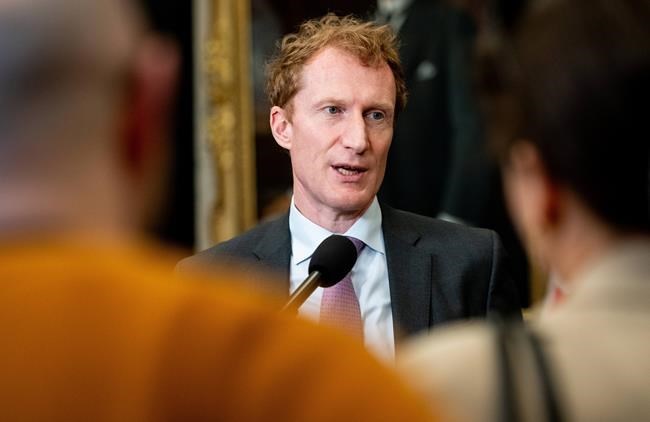MONTREAL — One way Canada plans to shrink the number of temporary residents is to offer them the opportunity to remain permanently, the immigration minister said Friday, but that doesn't mean everyone who wants to stay will be able to.
Marc Miller met with his provincial and territorial counterparts for the first time since he announced an unprecedented plan to set limits on the number of new temporary residents.
The aim is to rein in runaway growth, which has put pressure on the housing market and other services. The minister set a goal to reduce the number of temporary residents over the next three years to five per cent of Canada's population, down from the 6.2 per cent it was in 2023.
Several ministers warned the new policy would create added demand for their provincial immigration programs as temporary residents apply to stay in the country. They pitched expanding their provincial programs as a win-win solution to keep people in Canada permanently.¬Ý
"The fact people are already here, their impact on affordability has already been baked in, so it's smart," Miller said.¬Ý
"But it doesn't mean by extension that everyone's entitled to stay here or be here in Canada."
Ottawa can also do more to seek people who are already in Canada when it comes to federal permanent residency programs, he said.¬Ý
The new targets for temporary residents will be developed over the summer and published in the fall. The government hasn't yet settled on the limits it needs to set on new visas to reduce the temporary resident population.¬Ý
Miller asked provinces to share whatever data they have on the temporary resident population in their borders, including how many end up staying permanently under provincial nominee programs. He's also asked for a better picture of their capacity for newcomers and the pressure population growth is creating in their jurisdictions.
Already Miller has announced plans to scale back the number of international students by putting a two-year cap on new admissions in January.
The government is also attempting to speed up the time it takes to process asylum claims and, in the recent federal budget, included legislative measures designed to make the deportation process faster when those claims are denied.
The final and largest category that has yet to be addressed is temporary work permit-holders.
How to allocate a finite number of temporary visas was a focus of the talks, the ministers said in a press release after their meeting.
In 2018, there were 337,460 people with temporary work visas. By 2022, that number swelled to 605,851.
Miller has said it's a workforce the labour market has become addicted to in recent years.¬Ý
Every province will need to navigate how to overcome that addiction differently.
Saskatchewan Immigration Minister Jeremy Harrison says his province hasn't seen the same influx in temporary residents as some others, but the goal is still to transition them to permanent residency as much as possible.¬Ý
But in Manitoba, announcements out of Ottawa about scaling back temporary immigration have been met with an overwhelming surge in applications to the provincial nominee program for permanent residency.
Earlier this week, Miller agreed to Manitoba's request to extend the federal work permits for some 6,700 newcomers whose visas were set to expire by the end of the year, to give them time to apply to stay in Canada permanently through the provincial nomination program.
Manitoba's immigration minister hopes to see the provincial immigration program expanded down the line as a result.¬Ý
"My understanding was, if we are able to do this successfully then (Ottawa is) going to be looking upon that favourably and be able to increase our federal allocations," said Manitoba Immigration Minister Malaya Marcelino, referring to the province's immigration program.
Most provinces have asked for more control over their own immigration, and want to tailor the way the reduction in temporary residents will play out in their own labour markets.
The new temporary visa target will significantly slow population growth. While that could ease some pressure on housing costs and availability, it could also result in worker shortages, said Andrew Grantham, an executive director at CIBC Economics, in a report published last month.
"Restrictions on population growth could result in companies having to offer higher wages to encourage persons to remain in, or rejoin, the workforce. We could lose some firms that are simply not profitable if they are unable to tap low paid foreign workers," Grantham said.
While the federal and provinces governments promised to figure out that balance, labour economist Mikal Skuterud said work visas shouldn't be considered in isolation.
"You can't do that, it's part of the whole system," said Skuterud, an economist with the University of Waterloo.
He was among the first to warn the government to temper the massive rise in people who migrate to Canada on a temporary basis to work or study.
Skuterud credits that increase to changes to the criteria for permanent residents, which were designed to fill specific labour gaps. Those changes have created an incentive for lower-skilled workers to come to Canada in hopes of getting permanent residency.
"That's what's luring huge numbers to come, and it's creating this problem in the (non-permanent resident) population," he said.
That can make students and workers vulnerable to predatory practices by some recruiters, consultants and employers who can profit off their precarious status in Canada, he said.
He suggests the problem could be reversed by creating a more predictable and transparent path to permanent residency for newcomers.
This report by The Canadian Press was first published May 10, 2024.
Laura Osman, The Canadian Press




